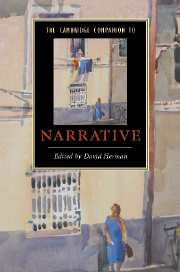Book contents
- Frontmatter
- Part I Preliminaries
- Part II Studying narrative fiction: a starter-kit
- Part III Other narrative media (a selection)
- 9 Conversational storytelling
- 10 Drama and narrative
- 11 Film and television narrative
- 12 Narrative and digital media
- Part IV Further contexts for narrative study
- Glossary
- Further reading
- Index
10 - Drama and narrative
from Part III - Other narrative media (a selection)
Published online by Cambridge University Press: 28 September 2007
- Frontmatter
- Part I Preliminaries
- Part II Studying narrative fiction: a starter-kit
- Part III Other narrative media (a selection)
- 9 Conversational storytelling
- 10 Drama and narrative
- 11 Film and television narrative
- 12 Narrative and digital media
- Part IV Further contexts for narrative study
- Glossary
- Further reading
- Index
Summary
From the outset, theories of drama and theories of narrative have been closely linked. Aristotle's Poetics, still the starting-point for any narrative theory, devotes more space to drama than to epic. The topics he covers, including character, plot, beginnings and endings, poetic justice, and the goals of representation, are as relevant to narrative theory as to a poetics of drama. Classic statements about these and other aspects of narrative, whether from the Renaissance, neo-classical, or Romantic periods, are likewise filled or even dominated by references to drama, as a look at the critical work of Castelvetro, Sidney, Dryden, Samuel Johnson, and Coleridge makes clear. Quite simply, if you are going to discuss plot and character, you must take drama and its theorists into account. Furthermore, performed stories, whether in drama, film, ballet, or video, have an additional enacted dimension that can interact with many of the other elements of narrative, particularly in the cases of character, time, and space. Strangely, while cinema was quickly brought into the fold of narrative theory, most notably in Seymour Chatman's Story and Discourse, drama has lagged behind, leaving a number of important theoretical contributions in the wings, as it were. Some recent theorists, following Genette, restrict the definition of narrative to stories that are told or narrated rather than enacted (though even in this limited case, as we will see, drama has important contributions to make). Many if not most theorists, however, follow Roland Barthes, who stated that “narrative is present in myth, legend, fable, tale, novella, epic, history, tragedy, drama, comedy, mime, painting (think of Carpaccio's Saint Ursula), stained glass windows, cinema, comics, news item, conversation.” I will be using this broader conception of narrative in the pages that follow.
- Type
- Chapter
- Information
- The Cambridge Companion to Narrative , pp. 142 - 155Publisher: Cambridge University PressPrint publication year: 2007
- 5
- Cited by

